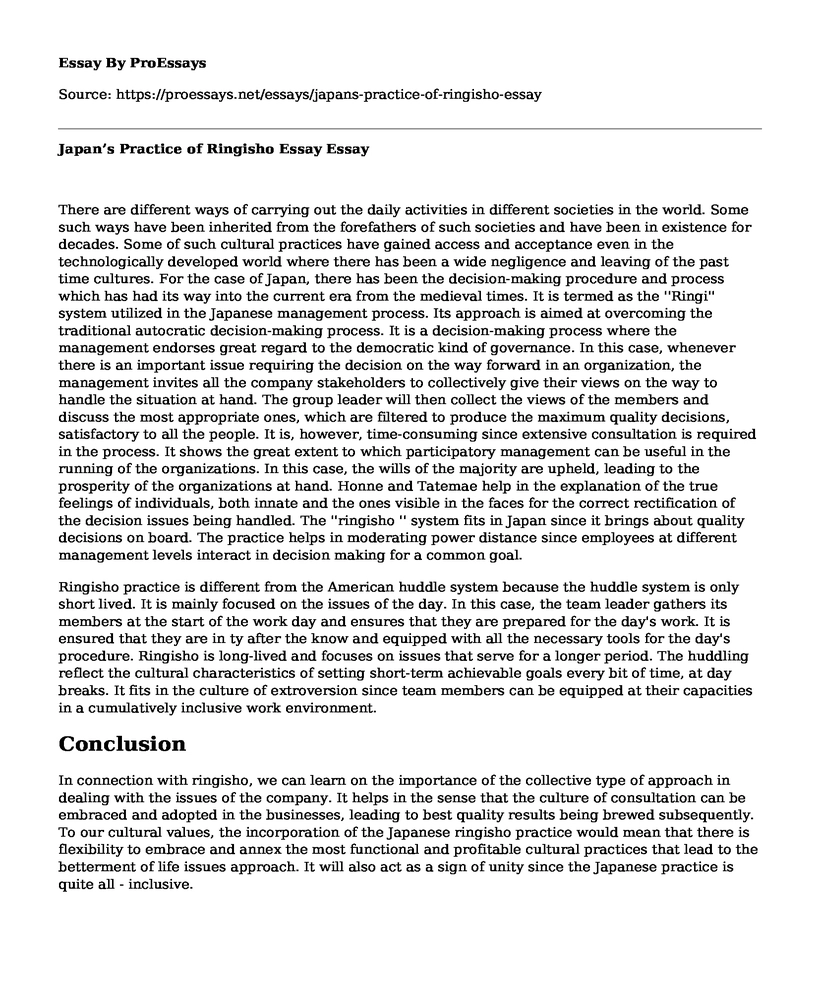There are different ways of carrying out the daily activities in different societies in the world. Some such ways have been inherited from the forefathers of such societies and have been in existence for decades. Some of such cultural practices have gained access and acceptance even in the technologically developed world where there has been a wide negligence and leaving of the past time cultures. For the case of Japan, there has been the decision-making procedure and process which has had its way into the current era from the medieval times. It is termed as the ''Ringi'' system utilized in the Japanese management process. Its approach is aimed at overcoming the traditional autocratic decision-making process. It is a decision-making process where the management endorses great regard to the democratic kind of governance. In this case, whenever there is an important issue requiring the decision on the way forward in an organization, the management invites all the company stakeholders to collectively give their views on the way to handle the situation at hand. The group leader will then collect the views of the members and discuss the most appropriate ones, which are filtered to produce the maximum quality decisions, satisfactory to all the people. It is, however, time-consuming since extensive consultation is required in the process. It shows the great extent to which participatory management can be useful in the running of the organizations. In this case, the wills of the majority are upheld, leading to the prosperity of the organizations at hand. Honne and Tatemae help in the explanation of the true feelings of individuals, both innate and the ones visible in the faces for the correct rectification of the decision issues being handled. The ''ringisho '' system fits in Japan since it brings about quality decisions on board. The practice helps in moderating power distance since employees at different management levels interact in decision making for a common goal.
Ringisho practice is different from the American huddle system because the huddle system is only short lived. It is mainly focused on the issues of the day. In this case, the team leader gathers its members at the start of the work day and ensures that they are prepared for the day's work. It is ensured that they are in ty after the know and equipped with all the necessary tools for the day's procedure. Ringisho is long-lived and focuses on issues that serve for a longer period. The huddling reflect the cultural characteristics of setting short-term achievable goals every bit of time, at day breaks. It fits in the culture of extroversion since team members can be equipped at their capacities in a cumulatively inclusive work environment.
Conclusion
In connection with ringisho, we can learn on the importance of the collective type of approach in dealing with the issues of the company. It helps in the sense that the culture of consultation can be embraced and adopted in the businesses, leading to best quality results being brewed subsequently. To our cultural values, the incorporation of the Japanese ringisho practice would mean that there is flexibility to embrace and annex the most functional and profitable cultural practices that lead to the betterment of life issues approach. It will also act as a sign of unity since the Japanese practice is quite all - inclusive.
Cite this page
Japan's Practice of Ringisho Essay. (2022, Jul 07). Retrieved from https://proessays.net/essays/japans-practice-of-ringisho-essay
If you are the original author of this essay and no longer wish to have it published on the ProEssays website, please click below to request its removal:
- Questions on Project Management
- Reflective Essay Example: Team Management
- Paper Sample: Complexities and Risks that Face Multinational Corporations
- Wine Producing Regions in the World Essay
- Principles of Food and Beverage Service Management Essay
- Power Dynamics: Influence and Control in Relationships - Essay Sample
- Paper Sample on Agricultural Sustainability - A Balanced Perspective







